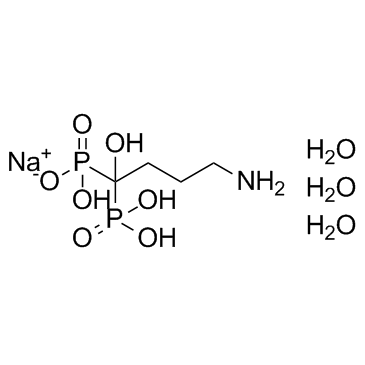
Alendronate sodium hydrate
CAS No. 121268-17-5
Alendronate sodium hydrate( Alendronate | MK 217 | G-704650 Adronat )
Catalog No. M10794 CAS No. 121268-17-5
Alendronate sodium hydrate (Alendronate;MK 217;G-704650 Adronat) is a bisphosphonate that acts as a specific inhibitor of osteoclastmediated bone resorption.
Purity : >98% (HPLC)
 COA
COA
 Datasheet
Datasheet
 HNMR
HNMR
 HPLC
HPLC
 MSDS
MSDS
 Handing Instructions
Handing Instructions
| Size | Price / USD | Stock | Quantity |
| 50MG | 36 | In Stock |


|
| 100MG | 43 | In Stock |


|
| 200MG | 49 | In Stock |


|
| 500MG | 77 | In Stock |


|
| 1G | Get Quote | In Stock |


|
Biological Information
-
Product NameAlendronate sodium hydrate
-
NoteResearch use only, not for human use.
-
Brief DescriptionAlendronate sodium hydrate (Alendronate;MK 217;G-704650 Adronat) is a bisphosphonate that acts as a specific inhibitor of osteoclastmediated bone resorption.
-
DescriptionAlendronate sodium hydrate (Alendronate;MK 217;G-704650 Adronat) is a bisphosphonate that acts as a specific inhibitor of osteoclastmediated bone resorption, inhibits osteoclast protein-tyrosine phosphatase (PTPepsilon) with IC50 of 2 uM; also inhibits the activities of other bacterially expressed PTPs such as PTPsigma and CD45, suppresses in vitro formation of multinucleated osteoclasts from osteoclast precursors and in vitro bone resorption by isolated rat osteoclasts with IC50 of 10 uM; also is also inhibits farnesyl disphosphate synthase with IC50 of 1.7 uM.Osteoporosis Approved(In Vitro):Alendronate, acting directly on osteoclasts, inhibits a rate-limiting step in the cholesterol biosynthesis pathway, essential for osteoclast function. Alendronate inhibits the isoprenoid biosynthesis pathway and interferes with protein prenylation, as a result of reduced geranylgeranyl diphosphate levels. Alendronate inhibits the incorporation of [3H]mevalonolactone into proteins of 18-25 kDa and into nonsaponifiable lipids, including sterols in osteoclasts. Alendronate causes a dose-dependent inhibition of [3H]MVA incorporation into sterols and a concomitant increase in incorporation of radiolabel into IPP and DMAPP. (In Vivo):Alendronate causes erosions in the rabbit stomach, but not antral ulceration in rats. Alendronate increases the incidence and size of indomethacin-induced antral ulcers. Alendronate also enhances indomethacin-induced gastricdamage in the rat, and delays gastric ulcer healing. Alendronate (0.04-0.1 mg/kg twice weekly or 0.1 mg/kg weekly) partially blocks the establishment of bone metastases by human PC-3 ML cells and results in tumor formation in the peritoneum and other soft tissues. Alendronate pretreatment of mice (0.1 mg/kg twice weekly or weekly) and dosing along with taxol (10-50 mg/kg/day, twice weekly, or weekly) blocks the growth of PC-3 ML tumors in the bone marrow and soft tissues in a statistically significant manner and improves survival rates significantly by 4-5 weeks.
-
In Vitro——
-
In Vivo——
-
SynonymsAlendronate | MK 217 | G-704650 Adronat
-
PathwayOthers
-
TargetOther Targets
-
RecptorFarnesyldiphosphatesynthase
-
Research AreaMetabolic Disease
-
IndicationOsteoporosis
Chemical Information
-
CAS Number121268-17-5
-
Formula Weight325.1237
-
Molecular FormulaC4H18NNaO10P2
-
Purity>98% (HPLC)
-
SolubilityH2O: ≥ 28.57 mg/mL; DMSO: < 3.2 mg/mL
-
SMILESOC(P([O-])(O)=O)(P(O)(O)=O)CCCN.[H]O[H].[H]O[H].[H]O[H].[Na+]
-
Chemical NamePhosphonic acid, P,P'-(4-amino-1-hydroxybutylidene)bis-, sodium salt, hydrate (1:1:3)
Shipping & Storage Information
-
Storage(-20℃)
-
ShippingWith Ice Pack
-
Stability≥ 2 years
Reference
1. Bergstrom JD, et al. Arch Biochem Biophys. 2000 Jan 1;373(1):231-41.
2. Opas EE, et al.Biochem Pharmacol. 1997 Sep 15;54(6):721-7.
3. David P, et al. J Bone Miner Res. 1996 Oct;11(10):1498-507.
4. Schmidt A, et al. Proc Natl Acad Sci U S A. 1996 Apr 2;93(7):3068-73.
molnova catalog



related products
-
Hydroxy Dimetridazol...
Hydroxy Dimetridazole is a hydroxy metabolite of Dimetridazole which combats protozoan infections.
-
Magnesium glycinate
Magnesium glycinate is a supplement that boost magnesium levels in people with a deficiency of the mineral.
-
Ro 31-8220 Mesylate
Ro 31-8220 is a pan-PKC inhibitor for PKC-α/βI/βII/γ/ε (IC50: 5/24/14/27/24 nM), and also shows potent inhibition against MSK1, MAPKAP-K1b, S6K1, and GSK3β.



 Cart
Cart
 sales@molnova.com
sales@molnova.com


